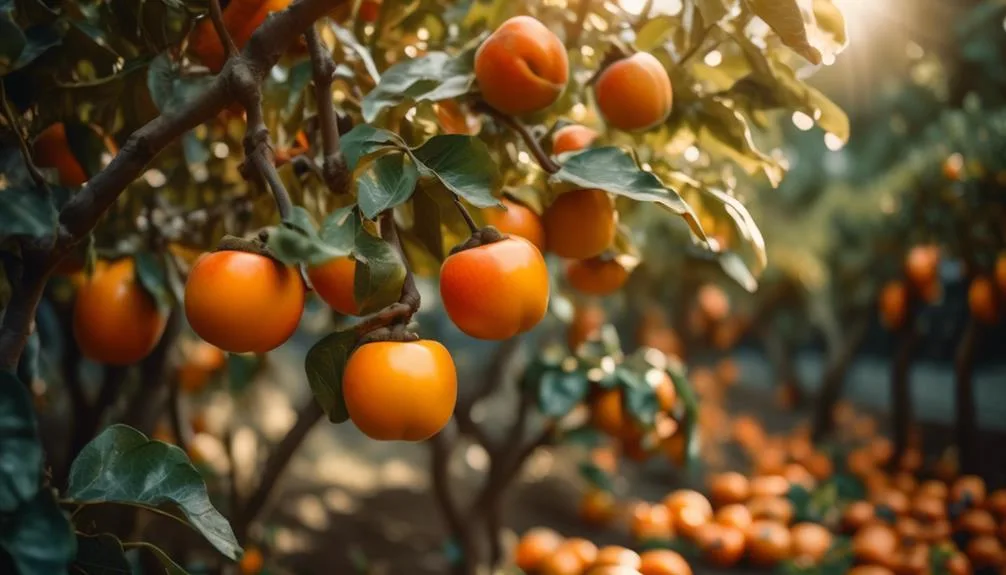Creating a feature garden with persimmon trees is like painting a beautiful picture. It takes careful planning and attention to detail. From choosing the right spot to caring for the trees, every step is important.
Join us as we explore the secrets to designing a stunning garden centered around these elegant trees.
Key Takeaways
- Choosing the right location and soil is crucial for the success of persimmon trees, including finding a sunny spot with well-draining soil and protection from strong winds.
- When selecting a persimmon tree variety, consider your climate and garden size, as well as the soil requirements of the chosen variety.
- Carefully plan the layout of your garden to strategically place and arrange the persimmon trees, considering visual impact and creating a captivating space.
- Proper care for persimmon trees includes regular pruning, providing adequate irrigation, and enhancing the garden with complementary plants that support tree health and beautify the landscape.
Choosing the Right Location
Have you found a sunny spot with well-draining soil and protection from strong winds for planting your persimmon trees?
Ideal soil for persimmon trees is well-draining loamy soil with a slightly acidic to neutral pH. Ensure the trees receive full sun exposure for at least six hours a day to promote fruit production. Persimmon trees have moderate water requirements, needing regular watering, especially during dry periods.
When planting, space the trees 20-25 feet apart to allow for adequate growth and airflow. Consider the garden aesthetics when choosing the planting location, as persimmon trees can be an attractive feature with their vibrant foliage and ornamental fruits.
Regular tree maintenance, such as pruning and fertilizing, is essential for healthy growth. Consider soil amendments and tree protection to ensure optimal growth and fruit production.
Selecting the Perfect Persimmon Tree
Once you've found the perfect sunny spot with well-draining soil for your persimmon trees, it's time to select the ideal tree for your feature garden. When choosing a persimmon tree, consider the variety that best suits your climate and garden size. Below is a helpful table to guide you:
| Persimmon Variety | Climate Suitability | Mature Size |
|---|---|---|
| Fuyu | Mild to Warm | 15-20 ft |
| Hachiya | Warm | 25-30 ft |
| Tamopan | Cold to Warm | 10-15 ft |
| Chocolate | Warm | 12-18 ft |
| Saijo | Mild to Warm | 15-25 ft |
Ensure the chosen variety aligns with your climate and garden space. Additionally, consider the soil requirements and be prepared to implement proper pruning techniques to maintain the health and shape of your persimmon trees.
Designing the Garden Layout
To create an aesthetically pleasing and functional garden layout featuring persimmon trees, carefully consider the placement and arrangement of the trees within your garden space. Plant placement is crucial for achieving aesthetic balance.
Grouping persimmon trees in clusters or creating a focal point with a single tree can add visual interest. Integrate pathways strategically to allow for easy access and to create visual flow throughout the garden. Consider how the pathways will interact with the placement of the persimmon trees, ensuring a harmonious balance between hardscape and greenery.
Additionally, think about the visual impact of the trees from different vantage points within the garden, such as from the house or other key viewing areas. By carefully planning the layout, you can create a captivating garden space featuring beautiful persimmon trees.
Caring for Your Persimmon Trees
Considering the thoughtful layout of your garden space, you can now focus on providing proper care for your persimmon trees to ensure their health and vitality. Here are three essential tips for maintaining your persimmon trees:
- Pruning Techniques:
Regularly prune your persimmon trees to remove dead or diseased branches, improve air circulation, and maintain an open center for sunlight penetration. Pruning in late winter or early spring, while the tree is dormant, encourages new growth and fruit production.
- Soil Requirements:
Ensure your persimmon trees are planted in well-draining, loamy soil with a slightly acidic to neutral pH. Amend the soil with organic matter, such as compost, to promote healthy root development and overall tree vigor.
- Maintenance:
Regularly monitor moisture levels, especially during the tree's establishment phase, and provide adequate irrigation during dry spells to promote healthy growth and fruit production.
Enhancing Your Garden With Complementary Plants
Enhance your garden with a vibrant array of complementary plants that not only beautify the landscape but also support the health and growth of your persimmon trees. Carefully selecting plant combinations can create a visually striking garden with color contrast that accentuates the beauty of the persimmon trees. Consider planting low-growing, shade-tolerant plants such as hostas or ferns beneath the persimmon trees to create a lush, layered look. Surround the base of the trees with a mix of vibrant flowers like astilbes, coral bells, and impatiens to add pops of color. Below is a table showcasing some plant combinations that work well with persimmon trees:
| Plant Combination | Height | Color |
|---|---|---|
| Hostas and Ferns | Low-growing | Green |
| Astilbes | Medium | Various |
| Coral Bells | Low to High | Red, Pink |
| Impatiens | Low | Various |
Conclusion
Incorporate persimmon trees into your garden to create a stunning focal point and enjoy the delicious fruit they produce. Choose a sunny spot, select the right tree, and design a layout that enhances your space. With proper care, your persimmon trees will thrive, adding beauty and bounty to your garden.
Consider adding complementary plants to complete the look and create a truly enchanting garden retreat.
Happy gardening!

